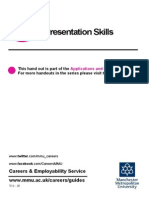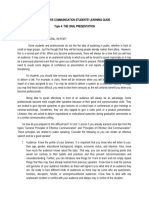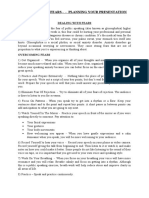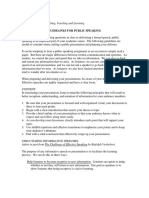Making Presentations: ://pat - Ipti.edu - My/login/index - PHP&H Bda14
Making Presentations: ://pat - Ipti.edu - My/login/index - PHP&H Bda14
Uploaded by
janeCopyright:
Available Formats
Making Presentations: ://pat - Ipti.edu - My/login/index - PHP&H Bda14
Making Presentations: ://pat - Ipti.edu - My/login/index - PHP&H Bda14
Uploaded by
janeOriginal Description:
Original Title
Copyright
Available Formats
Share this document
Did you find this document useful?
Is this content inappropriate?
Copyright:
Available Formats
Making Presentations: ://pat - Ipti.edu - My/login/index - PHP&H Bda14
Making Presentations: ://pat - Ipti.edu - My/login/index - PHP&H Bda14
Uploaded by
janeCopyright:
Available Formats
http://elearnjtp.ipgkti.edu.
my/
http://www.facebook.com/l.php?u=http
%3A%2F%2Fpat.ipti.edu.my%2Flogin%2Findex.php&h=bda14
Making Presentations
Sometimes you must make a presentation to an audience and will probably feel anxious about it.
However be confident. Adrenalin sharpens your abilities. Anxieties are eased with practice as
and you develop your verbal and non-verbal communication skills. If you have done your
preparation - you will know more than your audience.
Planning, preparation and practice are crucial.
Planning a Talk involves
Deciding what you want to talk to the audience about (clear objectives)
Considering what your audience will want to get out of it (the results)
Considering what you will want to get out of it (your results particularly if the
presentation is being assessed)
The points will you want to put over - the main headings and components points and their
sequence
How these points can be put over best?
Preparation includes
scheduling your artwork, slide and /or handout preparation
obtaining/rehearsing with OHP, equip't. Checking screen, room layout etc.
inviting members of audience eg your client.
Sequencing your ideas Use a similar structure as for planning an essay introduction, main body,
conclusion/summary, but remember you need to make contact with your audience to gain and
maintain their interest. Try and involve them, you will enjoy yourself more and so will they.
use prompt cards or the Presentation outline form,
use you OHP slides to structure and sequence your talk
Don't write out the talk. Reading from a script kills your voice and blocks contact with
your audience!
Beginning
Be yourself: enthusiasm and interest are infectious
Involve the audience - look at them. Use your natural presence.
Don't talk to the wall or to your shoes. Nervousness is a feeling - it usually doesn't show.
Take a calm sip of water. Smile.
Remember
Don't be obsequious or fauning (too much thanks and praise of your audience).
Get confidence from your preparation but beware of TOO MUCH preparation.
Get the audience attention - introduce yourself and your topic. Apply the rule
First you tell 'em what you're gonna tell 'em
Then you tell 'em
Then you tell 'em what you've told 'em
Outline the talk - what is it about and what will be the main structure. Note any treats in
store or questions which may raise
Above all make the beginning clear.
Apply the KISS principle (keep it simple - stupid). Don't hurry - start and continue at an
even pace.
Decide on taking questions during or after the talk. Explain this and stick to it politely
and reasonably
The Middle
Remember how people absorb information and get tired.
Change the cadences of your voice.
Involve the audience with your smile.
Use your visual and other media to provide sequence and structure.
Plan your timing - allow enough time. Don't rush when you are over-running SUMMARISE and STOP. Any matters not covered can be the subject of questions.
Use of Media
Visual materials will illustrate the points you are making. Plan to use flip-charts and OHP slides
handouts -before, during or after the talk models experiments discussion - large or small groups
questions
The Overhead Projector (0HP) is useful for this:
AVOID putting too much information on an OHP slide
ensure the "point" size of text can be
your slides should ne clean, no spelling errors etc
DON'T use too many
seen by your audience
Watch how other people use the 0HP and learn from them.
Question/Answer Stage
Change your position, move towards your audience but maintain eye contact with
everyone.
Ask for comments and seek clarification if you do not understand a question.
Bring your audience into the discussion and control the discussion questioning to keep
questions broadly on the subject
If you really don't know the answer to a question - - SAY SO - note the question and
agree that you will bring an answer to the question subsequently.
To close the questioning session ask for one or two final questions
Wind Up
Summarise the outline of the talk. Finish on a high note.
Assessment of Presentations
Ensure you know what assessment criteria are being used and the standard required (e.g.
Novice Semester 1 Level or
Professional Semester 4/6.
Many of the criteria are indicated above - note assessment of the following
content of the presentation - the facts and critical issues raised.
Their sequence, explanation and the logic of the argument. The content reveals the depth
of investigation and familiarity with the subject matter.
Skill of presentation itself.
Your public speaking skills: pace, voice (projection and cadence), your gestures
and irritants
ability to communicate to an audience.
Building of rapport, projection of warmth, confidence
handling of questions.
Use of media aids to deliver your session
Some key points of assessment may emerge from processes you generate in the presentation e.g.
your creativity and sensitivity to the audience. Be aware of who is in the audience and their
critical focus .
Team Presentations
If you are asked to make a team presentation
co-ordinate your activities to ensure that the presentation is a team effort and not a series,
of individual presentations. Appoint an anchor person.
prepare your stage. Ensure all team members have a seat. Rehearse each person's use of
the OHP. Stress that non-active team members should avoid Pffaffing! Agree a 'you're
time is up' signal.
GET EVERYONE THERE!. There will be an expectation that each member's
contribution in preparation and in the presentation itself can be clearly identified and is
sufficient for an assessment to be made.
Peter's Placebo:
An ounce of image is worth of a pound of performance.
Select Your Content
audience, not yourself tell them what they need to know, not all you
Analyze Your Audience
Put yourself in the audience's shoes - try to understand your listener's level of understanding, th
reality, and anticipate what they want to know. Once you know what your audience wants, you
know!
how to "sell" the benefits of your topic to them.
Set Your Goal and Keep It Before You
Decide what it is you would like to happen as a result of your presentation. The four main goals
communication are to inform, to request for an action, to
build relationship. Decide which of these goals you are
achieve. Let your listeners know what you want them to do
beginning of your talk and again at the end. Present your basic idea and give them an outline of y
that would lead you and your audience to the desired result.
Do Your Homework
Research your topic speak about something you have earned the right to talk about through e
study. Anticipate questions, and make sure you have the facts to answer them.
"Develop reserve power", advised Dale Carnegie, "assemble a hundred thoughts around your
discard ninety... Always prepare so that you are ready for any emergency such as a change of e
of the previous speaker's remarks or a well-aimed question from the audience in the discussion
following your talk... This will give you reserve power, the power that makes people sit up and
Seize every opportunity to practice no professional in any field performs without practicing.
time in front of a group is your showcase.
How to Keep Your Audience Interested1
on has to be terrific and up-to-date. You have to prepare thoroughly.
on't pay attention to these items, you can lose the interest of your
eye contact.
dy language.
you're happy to be there.
around. Avoid using podiums.
your audience what you tell them.
re using flip charts, use two.
t your information instead of reading your notes.
Plan Your Format and Delivery
How you give your talk can be more important than what you say. Whenever possible speak fr
you have a formal written speech to deliver, use a marking system in the text to guide your del
Making a Powerful First Impression
The audience will make decisions about you from your first appearance, your words and the so
voice. You can't make a first impression twice. Plan your opening sentences and practice them
mirror. Use short sentences. Keep technical information at a minimum. Grab attention with a jo
interesting fact, a short anecdote, a quotation, a positive statement, a provocative question... so
designed to arouse curiosity and get the audience looking and listening to you.
How To Present with Passion
The Power of Passion
No matter what you are, we are all in sales. Selling is a transfer of emotions. When yo
your listeners sense how strongly you believe in what you're saying? If you want peop
their undivided attention and feel compelled to heed your advice, they must hear and
unwavering commitment to your message... More
Manage Expectations
Communication is a two-way street. Before you begin your
sual-aids.
our activities and presentation modes.
presentation, be sure your participants know what to expect. They will arrive with some precon
Your advance communication about your presentation needs to be clear to set the perceptions r
no confusion or disappointment.
Do More than Lecture
e audience involved.
There's nothing wrong with lecturing, as long as you realize the limitations. Lecturing is a way
information verbally and is teacher/trainer focused. The facilitator speaks and the learners liste
become easily bored and inattentive.
ood listener.
rself.
Short lectures or verbal presentations of information need to be enhanced and supported with v
activities directly related to the information being presented. In the classroom, the teacher can
information by assigning extra study or independent practice. In a workshop, activities are mor
small groups, games, buzz sessions, guided practice, role play, brainstorming. The idea is to
learners and stimulate them to participate in their own learning.
Provide for every type of learner visual, auditory and kinesthetic. Provide for everyone with
hear and do. You'll stimulate your learners, whether in the classroom or meeting room. They'll
learn more and retain it longer.1
The 10 Key Project Leader Skills
Creating a Sustainable Culture of Innovation
An 8-Step Process
Selling skills. The ability to promote and sell the project both within and o
organization. Presentation skills... More
How To Make an Effective Venture Presentation
the Garden: Train your workforce in the art and science of
By Terry Collison
skillful presentations... More
The history of venture financing is littered with the carcasses of truly worthy companies that ju
through financing.
Effective Format of Presentation
Venture Financing Process
ational opening. You must make a powerful first impression, inspire
se curiosity. Promise to tell the audience how they can get something
t. Lift your visor. Grab attention with an interesting fact, a provocative
a joke, a short anecdote, or an inspiring quotation.
uction. You must manage expectations. Before you begin your
ion, be sure your participants know what to expect. Set the tone and the
ell them how they will benefit from listening to your presentation...
Thats why Im so dedicated to giving entrepreneurs the keys to a potential investor
You must plan your pitch based on an awareness of how the investor is likely to be th
Then you must communicate to the investor that you intend to present your information in a w
the investor assess whether this opportunity represents a "fit" with the investors interests an
(notice: I didnt phrase that in terms of "whether or not this is a good investment")..
Confidence is the Key...
Plan the Parts of Your Presentation...
Our Brain Cannot Accept a Message When It:
Keep Your Audience's Attention...
Using Videos...
enough or the right kind of information
frame of reference
le to find a familiar hook to connect the new information to the current
mind
onnect the parts of what it's hearing as it has not been provided with an
resentation structure
You might also like
- Presentation Skills: Careers & Employability Service WWW - Mmu.ac - Uk/careers/guidesDocument6 pagesPresentation Skills: Careers & Employability Service WWW - Mmu.ac - Uk/careers/guidesJoana Styliano CostaNo ratings yet
- The Oral Presentation PPT PCDocument39 pagesThe Oral Presentation PPT PCWinsie GarciaNo ratings yet
- A Guide To Oral PresentationsDocument5 pagesA Guide To Oral Presentationsfrancais2No ratings yet
- Effective Presentation TechniquesDocument3 pagesEffective Presentation TechniquesKaziRafiNo ratings yet
- PURPOSIVE COMMUNICATION FinalDocument18 pagesPURPOSIVE COMMUNICATION FinalGeralyn Pelayo AlburoNo ratings yet
- The Oral Presentation-1-1Document6 pagesThe Oral Presentation-1-1Bianca Erika TorresNo ratings yet
- Module 4 Communication in Various Purposes Lesson 4 THE ORAL PRESENTATIONDocument12 pagesModule 4 Communication in Various Purposes Lesson 4 THE ORAL PRESENTATIONClarence EscopeteNo ratings yet
- Venue - The Venue Is Equally Important. Locate The Lights and If You HaveDocument12 pagesVenue - The Venue Is Equally Important. Locate The Lights and If You Havejames paul baltazarNo ratings yet
- Power Point - Oral PresentationsDocument15 pagesPower Point - Oral Presentationsstaciebouch100% (2)
- PreparationDocument7 pagesPreparationPes LoverNo ratings yet
- Handout 004-Sc-Tips For Effective Delivery-Feb-2022Document6 pagesHandout 004-Sc-Tips For Effective Delivery-Feb-2022Tahera AbbasNo ratings yet
- PURCOM (Semi Reviewer)Document25 pagesPURCOM (Semi Reviewer)zaidelfaye pagelaNo ratings yet
- Developing Presentation SkillsDocument4 pagesDeveloping Presentation SkillszionNo ratings yet
- Presentation Skills - 4P's: Plan, Prepare, Practice and PerformDocument3 pagesPresentation Skills - 4P's: Plan, Prepare, Practice and Performmh2666894No ratings yet
- EnglishDocument13 pagesEnglishbparinitha3No ratings yet
- M Skills NotesDocument13 pagesM Skills Notesjoseph.kabaso96No ratings yet
- Presentations SkillsDocument43 pagesPresentations SkillsHinata TachibanaNo ratings yet
- Communication For Various PurposesDocument39 pagesCommunication For Various PurposesKean Brean GallosNo ratings yet
- Curs 3 PresentationsDocument6 pagesCurs 3 PresentationsAdelle MoldovanNo ratings yet
- Presentation Skill by Hasna Fauziyah, 1206218921Document5 pagesPresentation Skill by Hasna Fauziyah, 1206218921hasssbolNo ratings yet
- Practical 4 Presentaion SkillsDocument4 pagesPractical 4 Presentaion SkillsGauravNo ratings yet
- Presentation МетодичкаDocument22 pagesPresentation МетодичкаYour Public ProfileNo ratings yet
- Technical Communication and Soft Skills Lab Presentation SkillsDocument3 pagesTechnical Communication and Soft Skills Lab Presentation SkillsrahulNo ratings yet
- Why and How To Make MoneyDocument3 pagesWhy and How To Make MoneyIlyass B.No ratings yet
- The Five Ps of Public PresentationsDocument3 pagesThe Five Ps of Public Presentationssavinplaton65No ratings yet
- Assignment English: Mahnoor AkhterDocument5 pagesAssignment English: Mahnoor AkhterMahnoor AkhterNo ratings yet
- Guidelines For Oral PresentationDocument5 pagesGuidelines For Oral PresentationseoNo ratings yet
- Types of PresentationsDocument8 pagesTypes of PresentationsNabeel AhmedNo ratings yet
- Business Communication AssignmentDocument19 pagesBusiness Communication AssignmentAditya SinghalNo ratings yet
- What Actually Is A SeminarDocument5 pagesWhat Actually Is A SeminaradeelsiddiquepsoNo ratings yet
- Effective Persentation XkillsDocument26 pagesEffective Persentation XkillsMazhar UllahNo ratings yet
- Guidelines For Oral PresentationsDocument4 pagesGuidelines For Oral Presentationsapi-268558649No ratings yet
- Semınar Slıde 5Document24 pagesSemınar Slıde 5oguzcin17No ratings yet
- Module 4Document12 pagesModule 4Ravi.GNo ratings yet
- Presentation Skills PCDocument14 pagesPresentation Skills PCvinay mauryaNo ratings yet
- Presentation Skills-Planning, Structure and Delivery: Types of Presentations Informative PresentationsDocument8 pagesPresentation Skills-Planning, Structure and Delivery: Types of Presentations Informative PresentationsGray FullbladyerNo ratings yet
- Tips For Kids On How To Nail Presentations in The ClassroomDocument6 pagesTips For Kids On How To Nail Presentations in The ClassroomAdHill TeacherNo ratings yet
- Seven Points To Consider When Giving A PresentationDocument2 pagesSeven Points To Consider When Giving A Presentationhaanhtuan198No ratings yet
- Oral Presentation: Minutes As Most Listeners Will Become Restless If It Is Longer. (If You Are Expected To Give A LongerDocument3 pagesOral Presentation: Minutes As Most Listeners Will Become Restless If It Is Longer. (If You Are Expected To Give A LongercarewellnesscentreNo ratings yet
- Presentation TopicsDocument6 pagesPresentation TopicsArjun TalwarNo ratings yet
- Presentation Skills EXPLANATIONDocument9 pagesPresentation Skills EXPLANATIONShumaila QadirNo ratings yet
- Dealing With Fears - Planning Your PresentationDocument5 pagesDealing With Fears - Planning Your Presentationnamrata100% (1)
- Give Great Presentations: How to speak confidently and make your pointFrom EverandGive Great Presentations: How to speak confidently and make your pointNo ratings yet
- Module 3 Public Speaking Conducting Training ProgramsDocument14 pagesModule 3 Public Speaking Conducting Training ProgramsHeidi100% (2)
- Guidelines For Public Speaking: Jacobson Center For Writing, Teaching and LearningDocument6 pagesGuidelines For Public Speaking: Jacobson Center For Writing, Teaching and Learningcaptainnkumar1043No ratings yet
- Hassnain IjazDocument12 pagesHassnain IjazHassnain IjazNo ratings yet
- Presentation Skills: Amity Institute of Engineering and TechnologyDocument10 pagesPresentation Skills: Amity Institute of Engineering and TechnologyAnkit AgrawalNo ratings yet
- 6 Presentation Skills 2Document18 pages6 Presentation Skills 2Arshia AkbarNo ratings yet
- Oral Presentation Skills (Notes)Document24 pagesOral Presentation Skills (Notes)Hammas khanNo ratings yet
- Appendix 1 HesDocument4 pagesAppendix 1 HesNorman Argie NofiantoNo ratings yet
- A Presentation Is:: Awayof: Informing Inspiring Motivating Other PeopleDocument24 pagesA Presentation Is:: Awayof: Informing Inspiring Motivating Other PeopleNasser AbdelhadiNo ratings yet
- Academic Presentations: How To Manage A Group PresentationDocument9 pagesAcademic Presentations: How To Manage A Group PresentationJungNo ratings yet
- Become A Great Public Speaker: Tips & Guidelines For An Effective Public SpeechFrom EverandBecome A Great Public Speaker: Tips & Guidelines For An Effective Public SpeechNo ratings yet
- Study Giving PresentationsDocument7 pagesStudy Giving PresentationsStephen WuNo ratings yet
- How To Make A Good PresentationDocument34 pagesHow To Make A Good PresentationahmedjamyNo ratings yet
- Topic 5 Presentation SkillsDocument5 pagesTopic 5 Presentation Skillssetawo8674No ratings yet
- Stepstoprepare For PresentationDocument6 pagesStepstoprepare For PresentationJhonny LemosNo ratings yet
- Q.1) What Are The Essential Steps For Planning, Preparing and Presenting The Speech? Write Any Two Steps in DetailDocument16 pagesQ.1) What Are The Essential Steps For Planning, Preparing and Presenting The Speech? Write Any Two Steps in DetailYasir ButtNo ratings yet
- The Modelling News - in Review - Ampersand Publishing's D7 Tractor - A Visual History Book.Document7 pagesThe Modelling News - in Review - Ampersand Publishing's D7 Tractor - A Visual History Book.Mark AbNo ratings yet
- Manuel de L'Opérateur WL32Document272 pagesManuel de L'Opérateur WL32pierre ThibodeauNo ratings yet
- Benchmarking of Oneplus-76Document11 pagesBenchmarking of Oneplus-76Hemasri ChinnuNo ratings yet
- ThiveDocument1 pageThiveCotton LogicNo ratings yet
- Visual Web Developer 2005 Express EditionDocument244 pagesVisual Web Developer 2005 Express EditionGeña GonzalesNo ratings yet
- No. Fouls: Captain's Signature in Case of ProtestDocument1 pageNo. Fouls: Captain's Signature in Case of ProtestFaith Wang100% (1)
- CS 11 - Exam 1 - Answer Key PDFDocument5 pagesCS 11 - Exam 1 - Answer Key PDFeduardo edradaNo ratings yet
- Jinnah GandhiDocument3 pagesJinnah GandhiAbdullah Amir100% (1)
- Updated lp2Document75 pagesUpdated lp2Francis ValdezNo ratings yet
- Construction Safety Checklist - EnglishDocument3 pagesConstruction Safety Checklist - EnglishTheodore Teddy KahiNo ratings yet
- INTRODUCTIONDocument2 pagesINTRODUCTIONEldonVinceIsidroNo ratings yet
- Research PaperDocument12 pagesResearch Paperapi-608950669No ratings yet
- Tutorial StocksDocument3 pagesTutorial StocksNguyên KhôiNo ratings yet
- List of Domains For Renewal/ Register: - : Title Category DomainDocument1 pageList of Domains For Renewal/ Register: - : Title Category DomainRemya menonNo ratings yet
- Introduction To Domestic TourismDocument52 pagesIntroduction To Domestic TourismCusap RegineNo ratings yet
- RPM TRACKLIST 64-To-101Document8 pagesRPM TRACKLIST 64-To-101benoit.bieNo ratings yet
- Creative Nonfiction Exam WeaponDocument3 pagesCreative Nonfiction Exam WeaponAlfred Abay-abayNo ratings yet
- Resolva As Tag Questions Abaixo Como Estudamos em Sala. Exemplo: It's Very ColdDocument4 pagesResolva As Tag Questions Abaixo Como Estudamos em Sala. Exemplo: It's Very ColdY 1 K 3 SNo ratings yet
- Keyboard TechniqueDocument5 pagesKeyboard TechniqueJOHNREY BASIDNo ratings yet
- University of Northern Philippines: IndividualDocument7 pagesUniversity of Northern Philippines: IndividualRoselyn Lazaro TamayoNo ratings yet
- Purushottam TandonDocument2 pagesPurushottam Tandondeeptisengar89357No ratings yet
- De Guzman Et. AlDocument58 pagesDe Guzman Et. AlJen DulayNo ratings yet
- Law On Sales Notes Chapter 1Document12 pagesLaw On Sales Notes Chapter 1Kurt Russel AduvisoNo ratings yet
- AP Laudato Si Orientation 2023Document4 pagesAP Laudato Si Orientation 2023Jahz Aira GamboaNo ratings yet
- Retained EarningsDocument4 pagesRetained EarningsHaru Haru100% (1)
- Mind Wars ArtDocument3 pagesMind Wars ArtBeth Book ReviewNo ratings yet
- Apac Financial Services Private LimitedDocument9 pagesApac Financial Services Private LimitedPari SethNo ratings yet
- Screenshot 2024-01-29 at 19.03.05Document20 pagesScreenshot 2024-01-29 at 19.03.0547z597rcf6No ratings yet
- Global Fruit & Vegetables Processing: Ibisworld Industry ReportDocument39 pagesGlobal Fruit & Vegetables Processing: Ibisworld Industry ReportChin Kai WenNo ratings yet
- Lesson 7 - Sexual BehaviorsDocument10 pagesLesson 7 - Sexual BehaviorsApril CaringalNo ratings yet

























































































